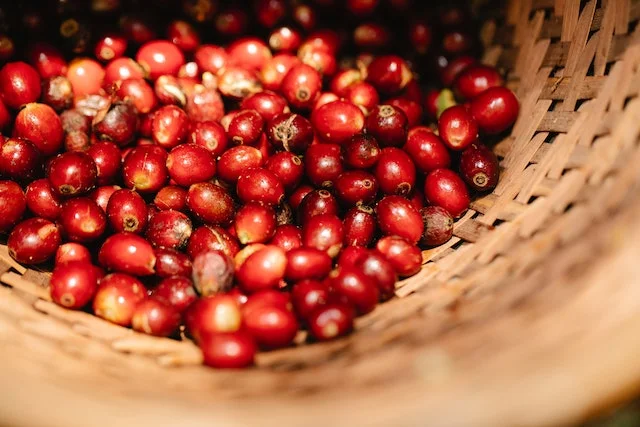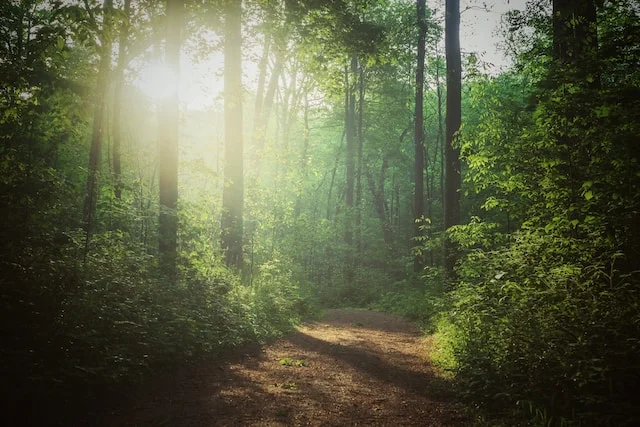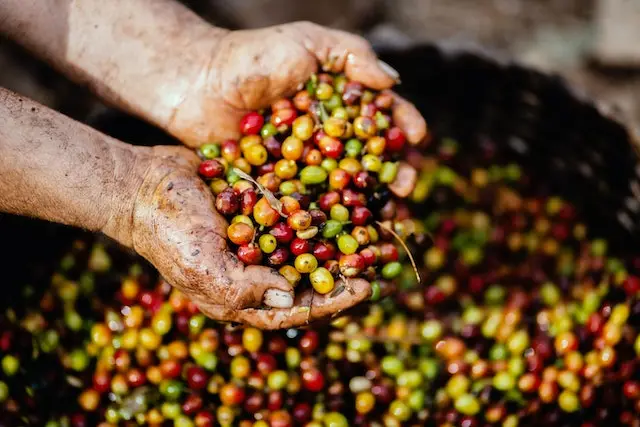Biodiversity in Coffee: An Introduction
Biodiversity refers to the incredible variety of plant and animal life on Earth. When it comes to coffee, biodiversity encompasses the range of coffee plant species and varieties along with the multitude of animals, insects, and ecosystems that are part of coffee growing regions around the world.
Why does biodiversity matter for coffee? Different coffee plant types provide protection against threats like diseases and pests. Having genetic diversity makes coffee crops more resilient. The diverse ecosystems and shade trees found on coffee farms give vital habitat for birds, pollinators, and other wildlife. Fostering biodiversity provides ecological benefits that support sustainable coffee production.
In this post, we dive into what biodiversity looks like across the world of coffee. We’ll learn about key coffee plant species, take a tour of coffee origins that are biodiversity hotspots, understand how coffee farms support habitats and wildlife, examine threats to biodiversity, discover conservation solutions, and see biodiversity’s influence on coffee flavor. Let’s explore the diverse living world behind coffee!
Key Takeaways
- Coffee Plant Diversity: Coffee’s biodiversity is based on the variety of coffee plant species and varieties.
- Biodiversity Hotspots: Coffee is grown in regions rich in biodiversity, like the Ethiopian Highlands and Latin America.
- Ecosystems on Coffee Farms: Coffee farms support diverse ecosystems through practices like shade-grown coffee.
- Threats and Conservation: Coffee biodiversity faces risks, but conservation efforts and certifications aim to protect it.
Coffee Plant Diversity: The Foundation
At the core of coffee biodiversity is diversity within the coffee plant species cultivated for commercial coffee production. While over 120 Coffea species exist in the world, mainly two are widely grown: Coffea arabica (Arabica) and Coffea canephora (Robusta). The characteristics and traits of these two plant species and their many varieties provide the base for broader biodiversity across coffee-growing regions.

Arabica Coffee
Arabica coffee makes up around 60% of global coffee production. It is valued for its sweeter, more nuanced flavor profile. However, Arabica also has some downsides:
- Arabica coffee has a relatively narrow genetic pool, which makes it vulnerable to threats like pests, disease, and climate change impacts.
- It thrives in cooler highland environments, which are being impacted by rising temperatures.
- There are over 1,000 varieties of Arabica, with popular ones including Typica, Bourbon, Catuai, and Gesha.
Robusta Coffee
The second most widely grown coffee species, Robusta comprises about 40% of global coffee. Some key facts on Robusta:
- It has almost double the caffeine content of Arabica coffee.
- Robusta is hardier, more disease resistant, and can be grown in lower altitudes and warmer temperatures.
- But it generally has a more bitter, earthy flavor profile than Arabica.
- Major Robusta varieties include Kouillou and Robusta Uganda.
Why Coffee Plant Diversity Matters
- Different coffee species and varieties provide resilience against threats. If Arabica was devastated by a pest it’s vulnerable to, Robusta could provide a crucial backup.
- Diversity offers adaptability to different climates and growing conditions. Farmers can select coffee varieties well suited to their environment.
- Wild coffee plant relatives contribute genetic diversity to develop hybrid cultivated coffee types with desirable traits like disease resistance.
Diverse coffee plant species and genetics provide the foundation for protecting the broader biodiversity of the coffee world.
Coffee Origins: Biodiversity Hotspots
Coffee is grown in some of the most ecologically rich and biodiverse regions of the planet. These coffee-growing areas harbor astonishing numbers of plant and animal species. Let’s explore some key coffee origins that are biodiversity hotspots:

Ethiopian Highlands
As the birthplace of Arabica coffee, Ethiopia’s highlands are part of the Eastern Afromontane biodiversity hotspot. Key facts:
- Ethiopia has over 6,500 plant species native to the country, 20% found only in Ethiopia.
- The highlands contain Africa’s largest continuous area of natural vegetation – over 7000 hectares of wild Arabica coffee forests.
- These forests preserve invaluable diversity of original Arabica varieties.
Latin America
Latin American countries like Colombia, Brazil, and Mexico have ideal coffee-growing conditions. Traditional shade-grown coffee farms under diverse native tree species canopies support high biodiversity.
- For example, the coffee regions of Chiapas, Mexico form part of the Mesoamerican biodiversity hotspot – one of the most biodiverse regions in the world.
Southeast Asia
Indonesia and Vietnam produce coffee across smallholder farms utilizing native varieties adapted to the tropical forests and diverse smallholder agroforestry systems.
- Indonesia’s unique Kopi Luwak coffee comes from the biodiversity-rich Sumatran rainforests.
- Vietnam’s Central Highlands also form part of the Indo-Burma biodiversity hotspot.
Africa
Beyond Ethiopia, countries across East, Central, and West Africa grow large amounts of shade coffee, helping preserve biodiversity hotspots like:
- The Eastern Arc forests of Kenya and Tanzania
- The Albertine Rift region of Uganda
- The Congo Basin rainforests
The world’s major coffee growing regions contribute invaluable biodiversity.
Diverse Ecosystems on Coffee Farms
Coffee farms themselves can promote biodiversity by providing forest-like habitats for plants and animals. Methods like agroforestry mirror natural ecosystems.
Shade-Grown Coffee
Growing coffee under a diverse, multi-layered canopy of native trees is a signature of traditional shade-grown coffee farming. This agroforestry approach provides habitat for many species:
- Birds: migratory, forest birds
- Mammals: squirrels, monkeys, civets
- Reptiles & Amphibians: snakes, lizards, frogs
- Insects: bees, butterflies, ants
Shade coffee farms can support up to 90% of bird species found in nearby natural forests. The biodiversity also delivers ecosystem services like pest control and pollination that benefit farmers.
Migratory Birds
In Latin America, traditional rustic shade coffee farms mimicking jungle cover provide important habitat for declining migratory bird species that breed in North America.
- Nicaragua’s coffee regions alone provide overwintering habitat for over 200 migratory bird species. The shade canopy offers food and shelter.
Pollinators
Bees, bats, butterflies, hummingbirds and other pollinators are drawn to coffee farms by the abundance of shade flowers and coffee blossoms itself.
- One Costa Rica study found bee populations remained stable in coffee farms while declining in nearby forests, showing coffee’s role in supporting pollinators.
- Maintaining natural habitat areas near coffee is also key for sensitive pollinator populations.

Sustainable Agriculture
Sustainable techniques like organic farming, reduced chemical use, and crop diversification create healthier on-farm conditions for biodiversity to flourish. Allowing native vegetation to grow also provides habitat.
Coffee farms can serve as essential ecosystems that parallel and support regional biodiversity.
Threats Facing Coffee Biodiversity
Despite coffee’s relationship with diverse ecosystems, coffee biodiversity faces real threats. Here are some of the key challenges:
- Climate Change: Rising temperatures, changing rainfall patterns, droughts, and extreme weather associated with climate change negatively impact coffee-growing environments. Deforestation exacerbates these effects.
- Pests & Diseases: Changing climate patterns assist proliferation of coffee pests and diseases like coffee rust and coffee berry borer beetle. These can damage biodiversity through necessitating pesticide use toxic to wildlife.
- Habitat Loss: Conversion of shade coffee and forests to sun coffee plantations strips biodiversity by removing tree cover and natural habitat.
Genetic Erosion: The genetic diversity of wild coffee species and untapped local varieties is being lost as Arabica and Robusta dominate global coffee. This genetic erosion leaves coffee more vulnerable.
Awareness of these threats is essential to guide conservation strategies. The challenges are real, but solutions exist.
Ongoing Conservation Efforts
Many sustainability initiatives already underway in coffee aim to protect biodiversity directly or indirectly:
Sustainable Coffee Farming
- Organic methods: avoid chemical pesticide and fertilizer use
- Agroforestry: use shade trees, diversify crops
- Efficiency: reduce water use, energy use, waste

Conservation Organizations
- Smithsonian Bird Friendly: promotes biodiversity through shade requirements
- Rainforest Alliance: protects ecosystems and wildlife
- Sustainable Coffee Challenge: brings together industry, producers, governments to collaborate on sustainability issues from deforestation to climate change.
Certifications
- Organic: prohibits chemicals harmful to environment and wildlife
- Bird Friendly: biodiversity criteria like shade cover, organic
- Rainforest Alliance: shade cover, conservation requirements
- Fair Trade: prohibits deforestation
Choosing certified sustainable coffees scales up consumer support for biodiversity conservation.
Biodiversity’s Impact on Coffee Flavor
Coffee’s incredible diversity directly influences the flavors in the cup through:
- Terroir: The local environment and climate of each coffee origin (terroir) shapes distinctive flavors.
- Coffee Regions: Different coffee regions produce unique flavor profiles based on coffee variety, growing conditions, processing methods.
- Specialty Coffee: Celebrates biodiversity through microclimates, new hybrids, organic growing, spotlight on specific origins.
A juicy Ethiopian natural coffee tastes wildly different from a chocolatey Sumatran not just by chance, but because of each region’s biodiversity.

Consumer Choices Supporting Biodiversity
As coffee lovers, we can support biodiversity through our purchases:
- Seeking out shade-grown and ** Bird Friendly** certified coffees
- Choosing certified sustainable coffees like organic and Rainforest Alliance
- Asking roasters and cafes about their sustainability practices
- Reducing consumption, avoiding waste, using reusable cups
Our habits and purchases add up to make a real difference.
Conclusion
This exploration illustrates that coffee biodiversity is intricate and multi-faceted, spanning from genetic diversity in coffee plants to broader ecosystem diversity in coffee’s lush tropical origins around the world. While very real threats endanger coffee biodiversity, proactive sustainability efforts combined with consumer awareness and action offer promise for preserving coffee’s irreplaceable biodiversity for generations to come. When we understand the diverse living world behind coffee, we can better appreciate each sip while making choices that protect coffee environments and the future of sustainable coffee production.








